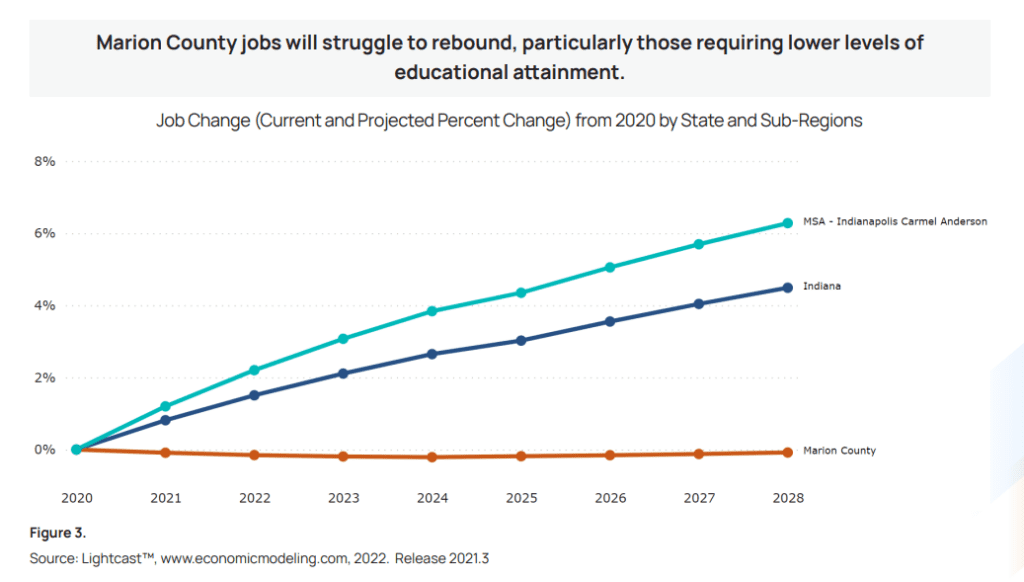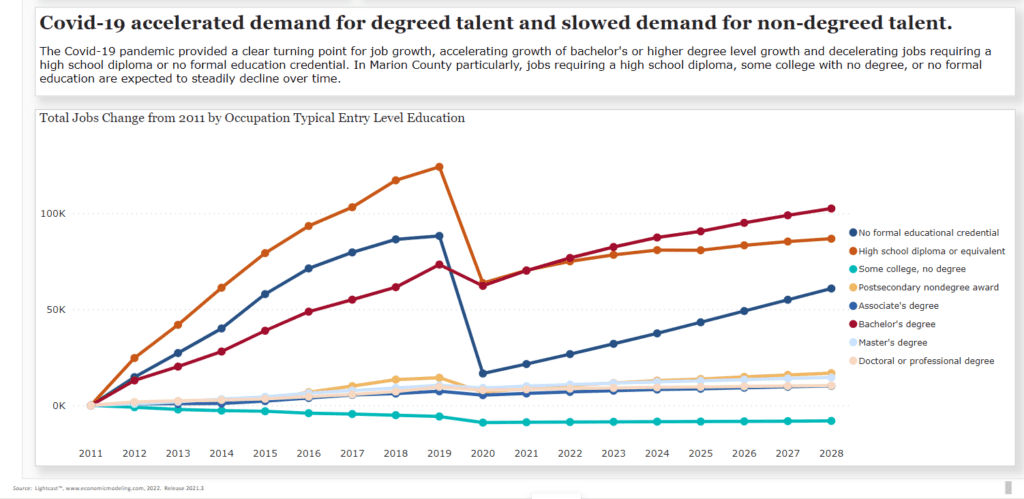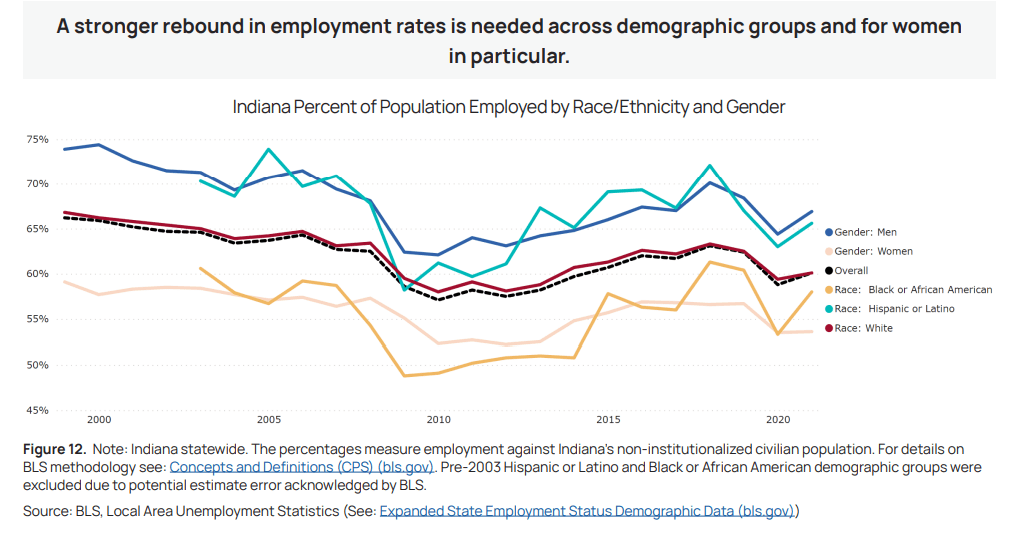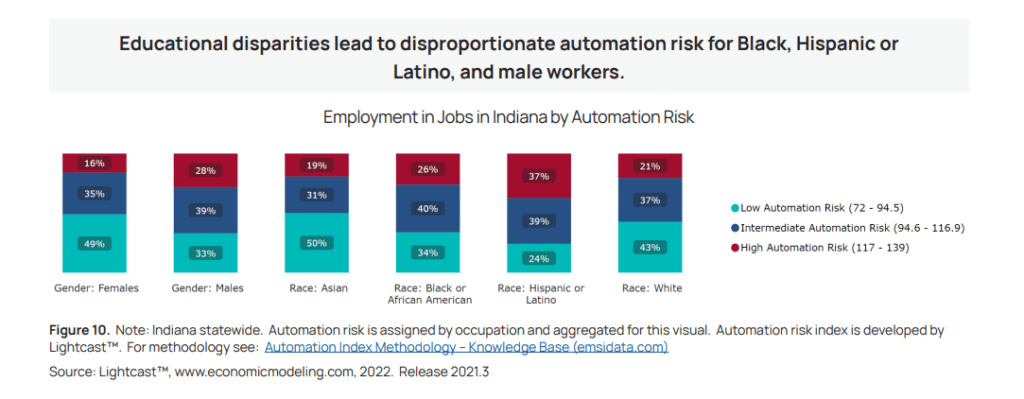A new report found the COVID-19 pandemic permanently shifted the job landscape in Marion County, showing a high demand for workers with postsecondary degrees at the same time that there is a significant decline in people completing degrees. Early childhood education is an important pipeline to job readiness and wealth, according to the report, which also shows gaps in postsecondary education reflect gaps in the workforce. Ascend Indiana President and CEO Jason Kloth said in a press release that it is important for Indiana to produce and retain college graduates.

“It is even more evident that additional steps need to be taken to assist Black and Hispanic/Latino students, who experienced the sharpest 2020 postsecondary enrollment declines during the pandemic, a trend that jeopardizes economic well-being for all,” Kloth said.
The report was produced by Ascend Indiana, Central Indiana Corporate Partnership and EmployIndy. The full report can be found here.
COVID-19 pandemic rapidly slowed the demand for non-degreed workers
The COVID-19 pandemic permanently altered Indiana’s job landscape by accelerating the demand for workers with degrees — referred to as degreed workers — while declining growth for non-degreed jobs. Jobs requiring bachelor’s degrees or higher account for a larger share of job growth and will continue to have the highest job growth with 90,000 new jobs by 2025, the report found. However, Marion County is projected to lose about 0.18% of jobs that require a bachelor’s degree as more jobs turn toward globalization, automation and digitization.
From 2011-2019, many new jobs in Indiana required a high school diploma or less and were growing at the highest rate compared to degreed jobs, the report found, but that number fell significantly during the pandemic and likely won’t rebound from pandemic lows in 2020.

Marion County has the highest concentration of people with high school diplomas and no degree. With a loss of good paying jobs for those people, that can be “very problematic” by leaving fewer opportunities for people without postsecondary degrees, Kloth said in an interview.
“If there are less jobs and lots of individuals with that level of educational attainment, those people cannot have transportation or access and mobility to get to those other jobs,” Kloth said. “So this is going to play out in really meaningful consequences long term for the social safety net.”
Not only will there be fewer opportunities, but a large majority of jobs will fall below the median wage. Of the 56,000 jobs projected to become available, only 10% are projected to earn above the median wage of $37,000 annually, said EmployIndy President and CEO Marie Mackintosh.
Too few high school students are going to college, furthering disparities
Black and Latino students experienced the sharpest decline in postsecondary enrollment after the pandemic. Postsecondary enrollment declined overall from 65% to 59% by 2019. In 2020, that number reached a new low at 53%.
A high school diploma is a basic requirement for most jobs. According to the Bureau of Labor Statistics, only 27% of jobs nationally require no high school diploma. Students who don’t graduate or graduate with a waiver diploma — a diploma with alternative graduation requirements — are less prepared for the modern labor market and postsecondary opportunities, according to the report.

The pandemic exasperated long-existing racial disparities in academics, according to the research. Black and Latino students were already falling behind before the pandemic in statewide grade-level proficiency exams in core subjects such as English language arts, math and science. The statewide exam —called ILEARN — is an exam that students in grades three through eight take to measure growth in accordance with Indiana’s curriculum standards. ILEARN performance dropped for all demographics in 2020-2021 but dropped most significantly for Black and Latino students.
Lack of academic preparation in lower grades carries over to high school performance and career readiness, according to the study. Black and Latino students, especially males, are less likely to earn a high school diploma or equivalency degree, leading to fewer job opportunities and lower wages.
Degree-level disparities directly transfer to job disparities
Black and Latino workers are more likely to work jobs that require no formal education and tend to make less than white people with the same degree and experience. Subsequently, Black and Latino students are less likely to pursue degrees in higher-paying jobs in science, technology, engineering and math — or STEM.

These educational disparities contribute to a higher risk of automation for Black and Latino workers, especially males. Black and Latino workers are underrepresented in high-paying, fast-growing careers, leading to disparities that carry over into the workplace. Disparities in job growth and educational attainment in Marion County “will likely present significant short—and near—term challenges associated with deepening poverty levels,” according to the report.
White male graduates tend to earn more than their peers, both immediately after graduating and three to five years later. There must be more students graduating from high school and enrolling in postsecondary education to fix the gaps in the labor market, the report said. Improving outcomes at each education stage would help address racial disparities in the workforce and postsecondary education attainment, the report said.
What can be done?
Ascend Indiana recommends a few opportunities to address racial gaps and provide equitable opportunities to quality jobs:
- Strong advising systems, automatic enrollment to Indiana’s 21st Century Scholars program, strengthened data collection and having FAFSA completion as a graduation requirement.
- Making internships more attainable to Black and Latino students and integrating them throughout the educational experience, including in high school and beyond. Ascend Indiana says employers should engage in education beginning in middle school, and extending to high school, by providing career exploration, engagement and experience opportunities such as internships or youth apprenticeships to students.
- Systematic changes such as a student transcript clearinghouse where postsecondary institutions can directly access a student’s transcript information and be used to attract, recruit, enroll and retain high school students. It also recommends providing incentives for education and training providers to increase enrollment and degree completion.
- Establishing a statewide commission to develop findings and recommendations to enable customized college and career advising to students, particularly students from low-income households and neighborhoods.
- Indiana should consider integrating FAFSA completion as a graduation requirement, Kloth said, as well as automatically enrolling students in the 21st Century Scholarship program.
“In order to create a prosperous community for everyone, we have to grow the quality of jobs. We want people in good jobs,” Kloth said. “So we want to grow those. At the same time, we have to increase the number of people who are educated, that align to where those jobs and that is the path towards solving this problem. That is the path that we need to be on and everything we should do as a city and the state should be on achieving that reality.”
Contact staff writer Jayden Kennett at 317-762- 7847 or by email jaydenk@indyrecorder.com. Follow her on Twitter @JournoJay.







